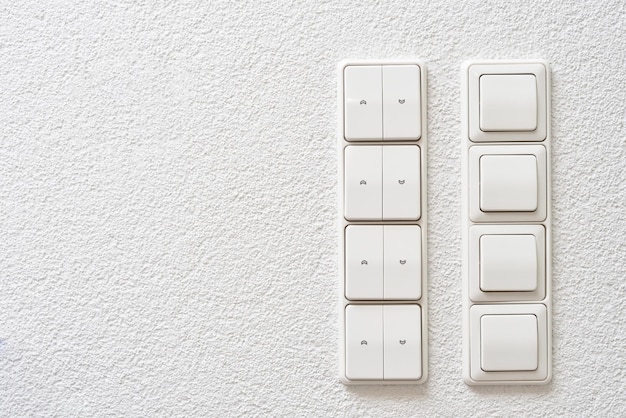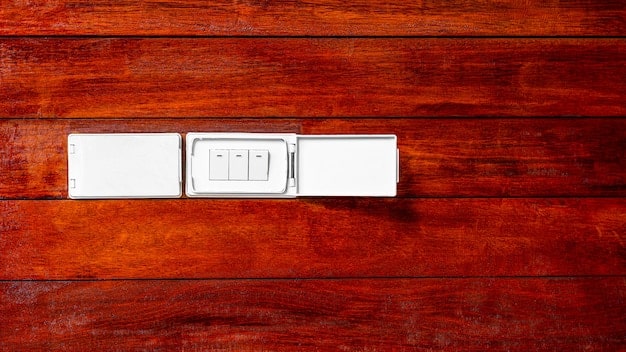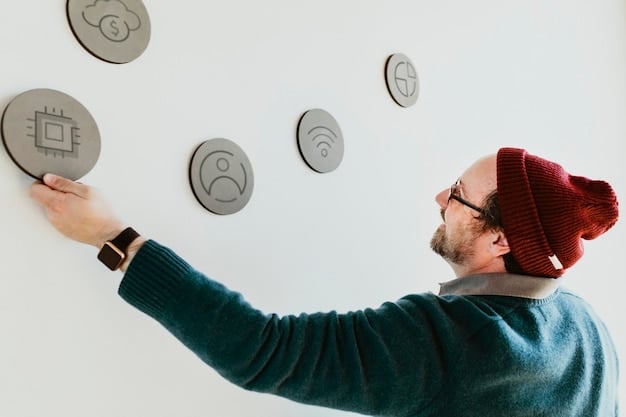Convert Standard Light Switches to Smart Dimmers: A $150 DIY Guide

Transform your home lighting affordably by converting standard light switches to smart dimmers with a budget of $150, enhancing ambiance and control via DIY smart home upgrades.
Ready to bring smart lighting into your home without breaking the bank? Converting your standard light switches to smart dimmers is a fantastic DIY project. With a budget of around $150, you can add convenience, energy savings, and a touch of modern technology to your living space. Let’s dive into how you can convert your standard light switches to smart dimmers with a $150 budget.
Understanding Smart Dimmers and Their Benefits
Smart dimmers are more than just fancy light switches; they offer a range of benefits that can significantly improve your home environment. They give you precise control over your lighting, allowing adjustments to suit different moods and activities. But what exactly makes them so appealing?
What are Smart Dimmers?
Smart dimmers are sophisticated light switches that replace your standard on/off switches. They connect to your home’s Wi-Fi network, letting you control your lights remotely using a smartphone app, voice commands via smart assistants like Amazon Alexa or Google Assistant, or even pre-set schedules.
Benefits of Using Smart Dimmers
- Energy Savings: Smart dimmers reduce energy consumption by allowing you to dim lights when full brightness isn’t needed.
- Enhanced Ambiance: Adjust your lighting to create the perfect atmosphere for movie nights, dinner parties, or relaxing evenings.
- Remote Control: Control your lights from anywhere using your smartphone, ensuring your home is well-lit even when you’re away.
- Increased Security: Schedule your lights to turn on and off at specific times, giving the impression that someone is home, deterring potential intruders.
Smart dimmers add convenience and sophistication to your home, all while helping you save energy and money.
Planning Your Smart Dimmer Conversion
Before you start tearing into your walls, careful planning is essential. This step involves assessing your current setup, understanding compatibility issues, and choosing the right products for your needs. Let’s look at the crucial steps to prepare for your smart dimmer conversion.

Assessing Your Existing Wiring
First, check your existing wiring. Smart dimmers often require a neutral wire, which may not be present in older homes. Open up your existing switch box to see the wires inside. You should see wires colored black (hot), white (neutral), and green or bare copper (ground). If there’s no neutral wire, you may need to hire an electrician to run one, which could increase your budget significantly.
Choosing Compatible Bulbs
Not all light bulbs are compatible with smart dimmers. Incandescent and halogen bulbs typically work well, but LED and CFL bulbs need to be specifically designed for dimming. Check the bulb packaging for terms like “dimmable LED” to ensure compatibility. Using non-dimmable bulbs with a smart dimmer can cause flickering, buzzing, or even damage to the dimmer switch.
Budget Considerations
While the goal is to stay within a $150 budget, it’s important to consider potential extra costs. This includes the cost of the dimmers themselves (typically $20-$40 each), any necessary tools, and the cost of compatible bulbs. Always factor in a buffer for unexpected expenses.
Thoughtful planning ensures a smooth and successful smart dimmer conversion, keeping your project on track and within budget.
Selecting the Right Smart Dimmers
With numerous smart dimmers available on the market, picking the right ones for your needs can be challenging. Consider factors like compatibility, features, and user reviews to make an informed decision. Here’s a breakdown to help you choose wisely.
Types of Smart Dimmers
- Wi-Fi Dimmers: These connect directly to your home Wi-Fi network, eliminating the need for a separate hub. They are easy to set up and control via a smartphone app.
- Zigbee or Z-Wave Dimmers: These require a smart home hub (like Samsung SmartThings or Wink) to function. They often offer more advanced features and better integration with other smart home devices.
- Bluetooth Dimmers: Bluetooth dimmers connect directly to your smartphone via Bluetooth. They are suitable for small spaces where proximity isn’t an issue, but they lack the range of Wi-Fi dimmers.
Top Recommended Smart Dimmers Under $50
Some popular and affordable smart dimmers include the TP-Link Kasa Smart Dimmer Switch, the Treatlife Smart Dimmer Switch, and the GE Enbrighten Z-Wave Smart Dimmer. These dimmers offer a good balance of features, ease of use, and price. Always read user reviews to get a sense of real-world performance and reliability.
Features to Look For
When selecting a smart dimmer, consider features like dimming range, voice control compatibility (Amazon Alexa, Google Assistant), scheduling capabilities, and integration with other smart home devices. Also, look for dimmers with a physical on/off button for manual control in case of network issues.
Selecting the right smart dimmers involves careful consideration of your home’s setup, your feature preferences, and your budget. Prioritize compatibility and ease of use for a seamless smart home experience.

Step-by-Step Installation Guide
Once you’ve gathered your supplies and chosen your smart dimmers, the next step is the installation process. Follow these detailed instructions to safely and correctly replace your standard light switches with smart dimmers. Remember to always prioritize safety and turn off the power before working with electrical wiring.
Safety First: Turning Off the Power
Before you begin any electrical work, turn off the circuit breaker that controls the light switch you’ll be working on. This is a crucial safety precaution to prevent electric shock. Double-check that the power is off by testing the switch with a non-contact voltage tester.
Removing the Old Light Switch
Remove the faceplate of the existing light switch using a screwdriver. Then, unscrew the switch from the electrical box. Carefully pull the switch out, and you’ll see the wires connected to it. Take a photo of the wiring configuration before disconnecting anything. This will serve as a reference when installing the new smart dimmer.
Wiring the Smart Dimmer
Using your reference photo, disconnect the wires from the old switch. Connect the wires to the new smart dimmer according to the manufacturer’s instructions. Typically, you’ll connect the black wire (hot) to the corresponding terminal on the dimmer, the white wire (neutral) to the neutral terminal, and the green or bare copper wire (ground) to the ground terminal. Use wire connectors (wire nuts) to secure the connections.
Securing the Smart Dimmer
Carefully push the wires back into the electrical box and secure the smart dimmer with screws. Install the faceplate. Turn the circuit breaker back on and test the new smart dimmer. If it doesn’t work, double-check your wiring connections and consult the manufacturer’s troubleshooting guide.
A methodical approach to installation ensures a safe and functional smart dimmer setup. Take your time, follow the instructions carefully, and don’t hesitate to seek professional help if needed.
Setting Up and Configuring Your Smart Dimmers
With your smart dimmers physically installed, the next step is to connect them to your home network and configure them for optimal performance. This involves downloading the manufacturer’s app, connecting to your Wi-Fi, and customizing your lighting preferences. Let’s walk through the setup process.
Downloading the Manufacturer’s App
Most smart dimmer brands have a dedicated mobile app available for iOS and Android devices. Download the app from the App Store or Google Play Store and create an account. This app will be your primary interface for controlling and customizing your smart dimmers.
Connecting to Your Wi-Fi Network
Follow the app’s instructions to connect your smart dimmer to your home Wi-Fi network. This usually involves putting the dimmer into pairing mode and entering your Wi-Fi password. Make sure your Wi-Fi network has a strong and stable signal for reliable performance.
Customizing Settings and Preferences
Once connected, you can customize various settings and preferences. This includes setting schedules for automatic on/off times, creating scenes for different lighting scenarios (e.g., “Movie Night,” “Dinner Party”), and linking the dimmer to your smart home ecosystem, such as Amazon Alexa or Google Assistant.
Proper setup and configuration unlock the full potential of your smart dimmers, giving you complete control over your home lighting and enhancing your daily life.
Troubleshooting Common Issues
Even with careful planning and installation, you might encounter some issues with your smart dimmers. Here are some common problems and their solutions to help you keep your smart lighting system running smoothly.
Dimmer Not Responding
If your smart dimmer isn’t responding, first check that the circuit breaker is on and that the dimmer is properly connected to your Wi-Fi network. Try power cycling the dimmer by turning off the circuit breaker for a few seconds and then turning it back on. If the problem persists, consult the manufacturer’s troubleshooting guide or contact customer support.
Bulbs Flickering or Buzzing
Flickering or buzzing bulbs are often caused by using non-dimmable bulbs with a smart dimmer. Ensure that you are using compatible dimmable LED or CFL bulbs. Also, check that the dimmer is rated for the type and wattage of the bulbs you are using.
Connectivity Problems
Connectivity issues can arise if your Wi-Fi signal is weak or unstable. Try moving your Wi-Fi router closer to the smart dimmer or using a Wi-Fi extender to improve signal strength. Also, check that your Wi-Fi password is correct and that your smart dimmer is properly connected to your network in the manufacturer’s app.
Addressing common issues promptly ensures the long-term reliability and performance of your smart dimmers. Don’t hesitate to seek professional help if you can’t resolve the problem yourself.
| Key Point | Brief Description |
|---|---|
| 💡 Smart Dimmers | Enhance ambiance and control lights remotely. |
| 🛠️ Planning | Assess wiring and choose compatible bulbs. |
| 💰 Budget | Aim for $150, including dimmers and tools. |
| 🔌 Installation | Turn off power, wire dimmer, and test functionality. |
Frequently Asked Questions
▼
Smart dimmers can be installed by following instructions carefully and ensuring all safety measures are in place. If unsure, consult a qualified electrician.
▼
Use dimmable LED, CFL, or traditional incandescent bulbs. Check for “dimmable” on the packaging to ensure compatibility and function correctly.
▼
Not necessarily. Wi-Fi dimmers connect directly to your home’s Wi-Fi without a hub, while Zigbee or Z-Wave dimmers need a hub like SmartThings.
▼
Yes, most smart dimmers are compatible with voice assistants like Amazon Alexa and Google Assistant, making hands-free control convenient.
▼
If there’s no neutral wire, you may need to hire an electrician to install one or choose smart dimmers specifically designed for homes without neutral wires.
Conclusion
Converting your standard light switches to smart dimmers on a $150 budget is a feasible and rewarding DIY project. By planning carefully, selecting the right dimmers, and following the installation steps, you can enhance your home’s lighting, save energy, and add a touch of modern convenience.





